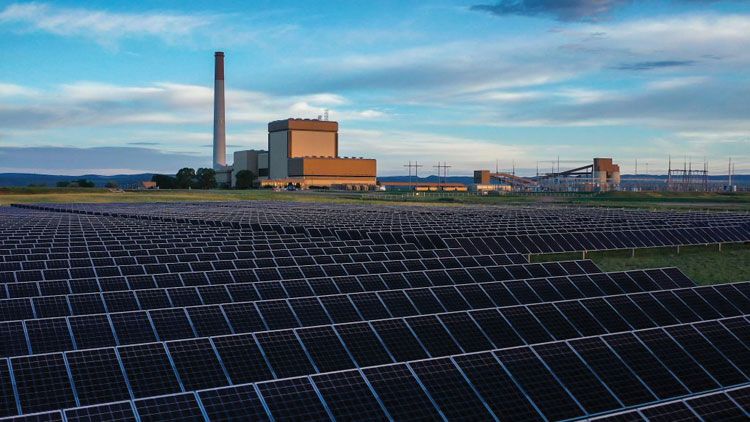All eyes on 2030: Utilities set sights on renewable energy

The next nine years will prove how committed local electricity utilities are to the cause of developing new renewable energy sources. It’s put-up-or-shut-up time.
Many of the Boulder Valley and Northern Colorado electricity providers and local governments have circled 2030 as the year when they’ll deliver on promises to transition completely or mostly away from carbon-based sources of power.
Cities such as Boulder and Longmont have passed resolutions to provide 100% renewable energy to residents by 2030, while utilities such as Xcel Energy Inc. (NYSE: XEL) and Poudre Valley Rural Electric Association Inc. have pledged to get 80% there.
SPONSORED CONTENT
Federal District Court Rules Corporate Transparency Act Unconstitutional . . . But Most Small Businesses Must Still Comply
Lyons Gaddis Real Estate and Business Attorney Cameron Grant shares important details of the Corporate Transparency Act (CTA).
Platte River Power Authority spokesman Steve Roalstad said the push for renewables has been “customer driven,” and utilities and local leadership have bought into the process.
“I’ve got to hand it to Platte River and the people in this community for saying, ‘Let’s give it a whirl,’” he said.
Interestingly, PRPA produced 100% renewable energy up until the 1970s using a hydroelectric power plant, Roalstad said. But eventually, the booming Northern Colorado region outgrew the plant’s capacity.
“With the advent of the use of air conditioning in Colorado, the demand curve changed drastically,” he said, and utilities turned to natural gas and coal to meet this demand.
Now the industry, facing pressure from leaders and residents to address climate change, is moving away from those carbon-based energy sources. To replace coal and gas, utilities are looking to wind and solar energy.
PRPA added 30 megawatts of solar power at its Rawhide Station outside of Wellington in 2016. The association then added 225 megawatts of new wind power this year and hopes to add another 22 megawatts of solar in the next month or so. PRPA also expects to enter into a new power purchase agreement to bring on additional solar in the coming year.
By 2024, the utility hopes to produce 60% of its electricity from renewables.
Solar-generated electricity doesn’t have to be bought as part of a power purchase agreement; it can come from a utility’s own customers.
“One of things we’re seeing is more customer use of small scale residential solar panels on their own homes,” Longmont Power & Communications spokesman Scott Rochat said.
Two years ago, the utility had 234 solar customers, he said. This year, the total is up to 400
“It’s quick growth.”
In October, PRPA’s board of directors approved its 2020 integrated resource plan.
The IRP studied multiple options to achieve 100% noncarbon and selected what it called Portfolio 2. This path eliminates coal generation but maintains some natural-gas generation, along with wind and solar, in order to hold down costs while maintaining reliability.
Xcel is in a unique position to be held accountable for its carbon reduction promises. Boulder voters approved a deal in November that provides a pathway for the city to end its decade-long effort to form a municipal utility and re-enter a franchise agreement with Xcel.
Xcel agreed to reduce its 2005 carbon-emission levels by 80% by 2030, as well as help Boulder achieve its goal of 100% renewable energy by the same year. If Xcel fails to meet those requirements, the city has six opportunities to terminate the agreement — in 2023, 2025, 2026, 2028, 2031, and 2036.
“In Boulder specifically, the Valmont Generating Station’s coal unit was retired in 2017 as part of [Clean Air Clean Jobs Act],” Xcel spokeswoman Michelle Aguayo said in an email. “We will also retire two additional coal units, while adding new renewable energy to our system as part of the Colorado Energy Plan approved by the commission two years ago. That will allow us to achieve up to 55% renewable energy in Colorado, with a 60% reduction in carbon by 2026. Early next year we will propose a new clean energy plan in Colorado and are evaluating additional coal plant retirements or reduced coal operations as part of the plan.
As part of the Boulder franchise agreement, Xcel has also pledged to support programs such as electrification of city buses through an energy partnership agreement
“We’ve already hit the ground running by establishing teams to work together to tackle important issues the voters agreed to, including working on state regulation regarding rooftop solar capacity. We’ve also started policy discussions to integrate our work moving forward,” Aguayo said.
In November, Tri-State Generation and Transmission Association Inc. increased its goal of movement toward non-carbon-generated electricity from 70% by 2030 to 80%.
The utility will accomplish the reduction in coal-fired generation by shutting down its coal plants in Craig in 2028 and 2029, increasing its use of renewable power through development of additional wind and solar resources, and working with other regional utilities to improve transmission resources so that a large area of the West will have access to more clean energy on a reliable scale, Tri-State CEO Duane Highley said during a press conference last month.
United Power Inc. is locked in a legal dispute with Tri-State, its electricity wholesaler, over United’s attempts to divorce itself from Tri-State. One of the reasons United Power says it wants to leave Tri-State is Tri-State’s hesitance to move away from coal power plants.
For its part, United Power offers customers access to several renewable energy programs such as the Green Power Partners program, which allows users to buy 100 kilowatt-hour blocks of solar power.
Participation in the program “helps to direct our power supplier, Tri-State Generation and Transmission, to purchase new, renewable energy to add to our power mix,” according to United Power.
While the development of renewable energy is important to utility customers, it’s not the most important issue for them.
Reliability is foremost on customers’ minds, followed by affordability, then carbon emissions, according to a recent PRPA survey.
“When you look at the plans for 100% renewable energy by 2030, there’s always an asterisk that says, ‘As long as technology can get us there,’” Poudre Valley REA spokesman Sam Taggart said.
Without continued advancement in technology, the shift toward renewables is likely to be an expensive process, one that’s ultimately shouldered by utility customers.
“For the members, we don’t want to just put in a gigawatt of renewable energy if it’s going to cost them a huge price tag to do that,” he said.
The next nine years will prove how committed local electricity utilities are to the cause of developing new renewable energy sources. It’s put-up-or-shut-up time.
Many of the Boulder Valley and Northern Colorado electricity providers and local governments have circled 2030 as the year when they’ll deliver on promises to transition completely or mostly away from carbon-based sources of power.
Cities such as Boulder and Longmont have passed resolutions to provide 100% renewable energy to residents by 2030, while utilities such as Xcel Energy Inc. (NYSE: XEL) and Poudre Valley Rural Electric Association Inc. have…
THIS ARTICLE IS FOR SUBSCRIBERS ONLY
Continue reading for less than $3 per week!
Get a month of award-winning local business news, trends and insights
Access award-winning content today!


